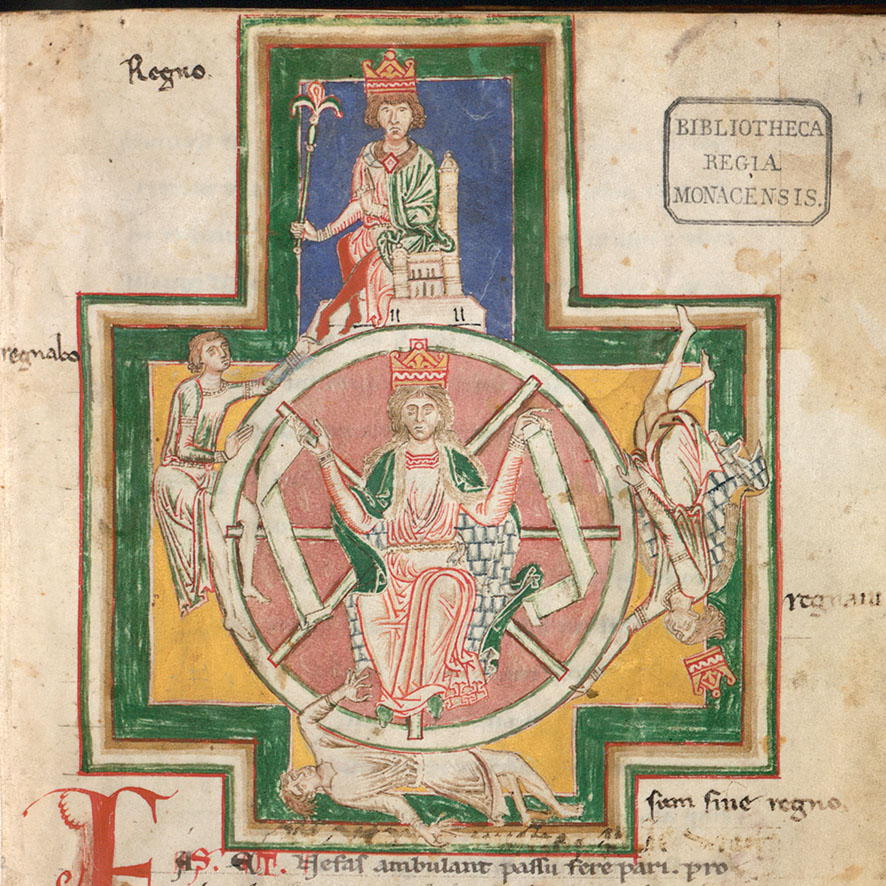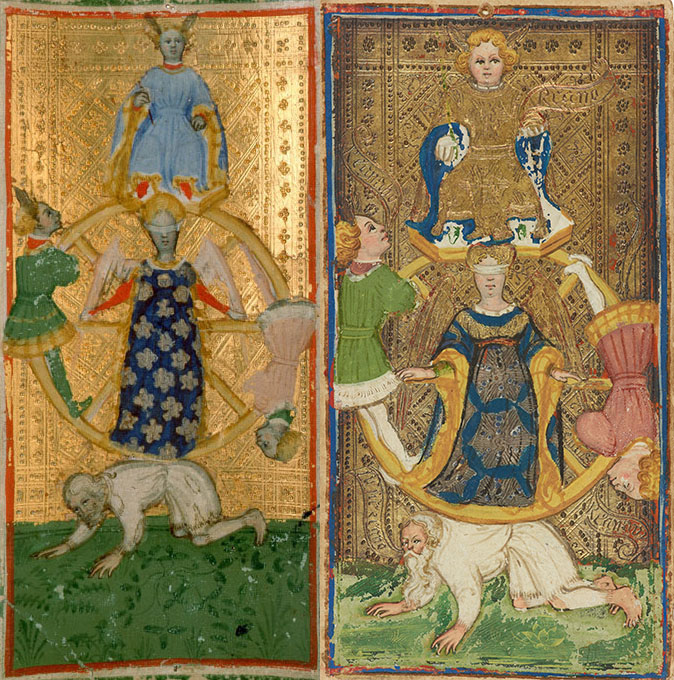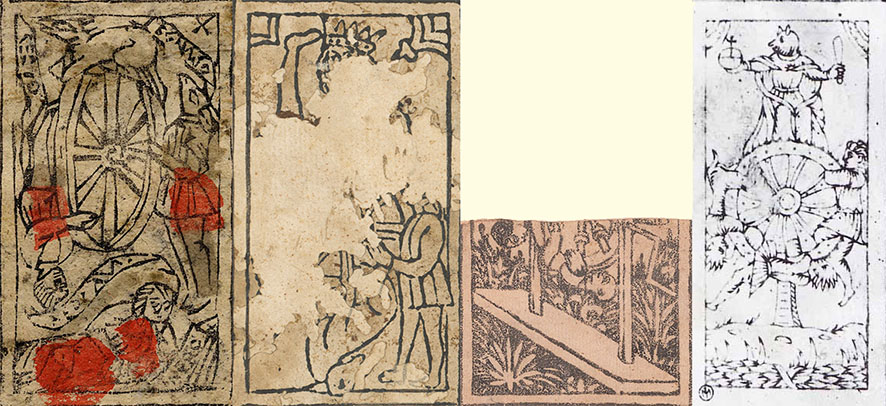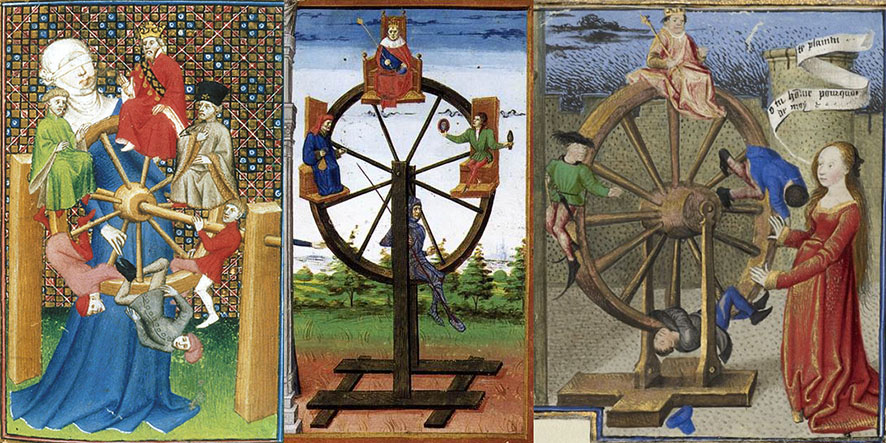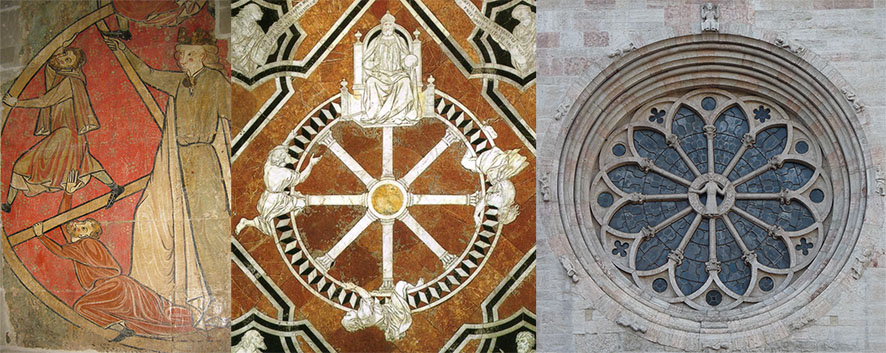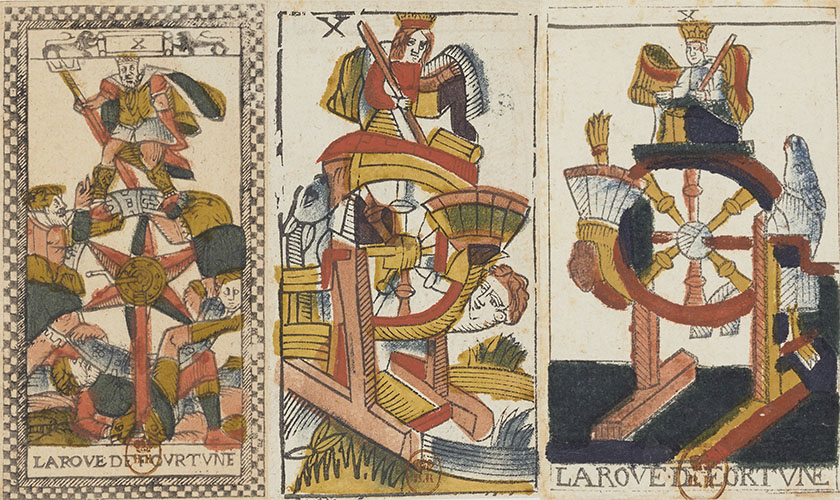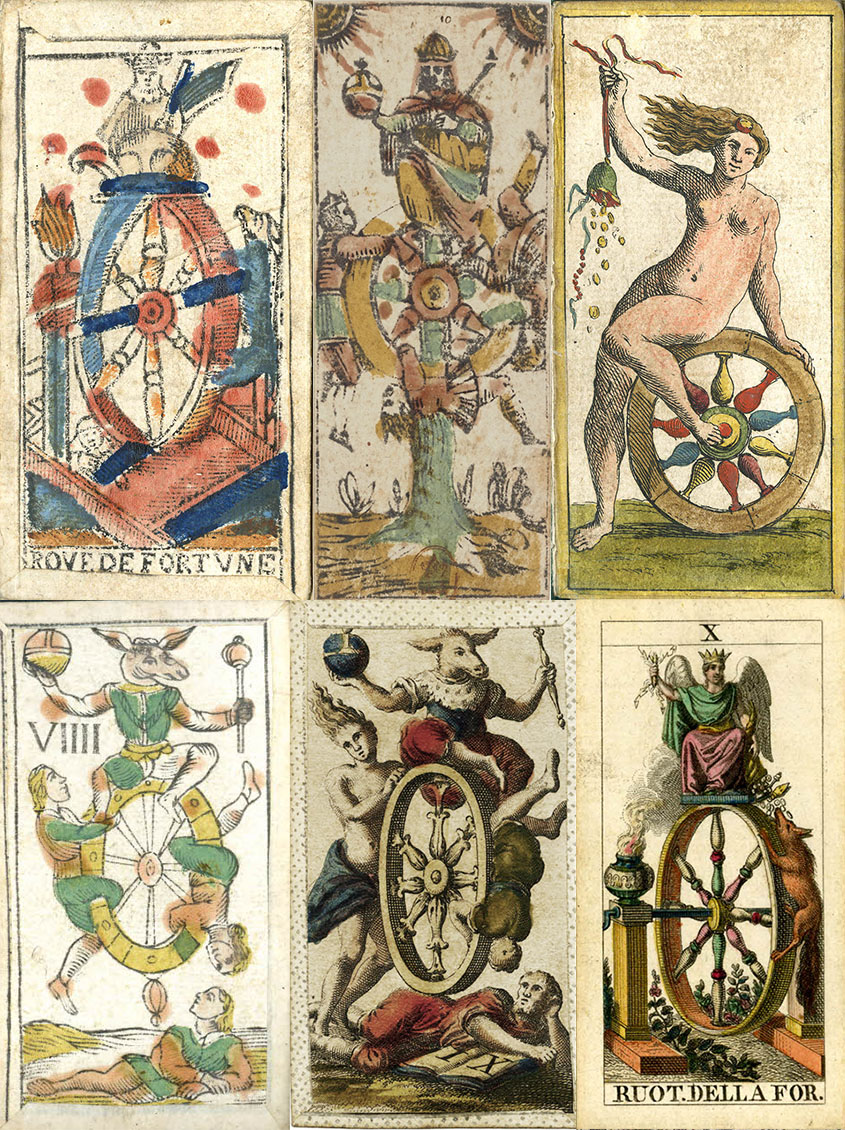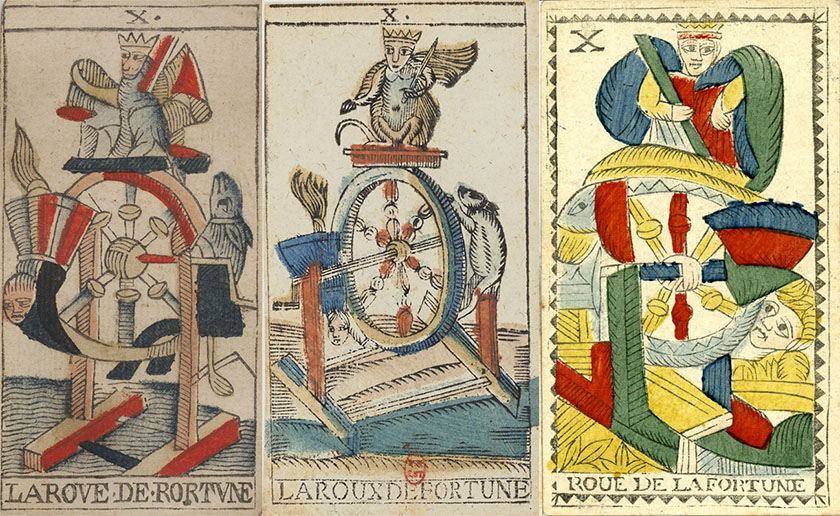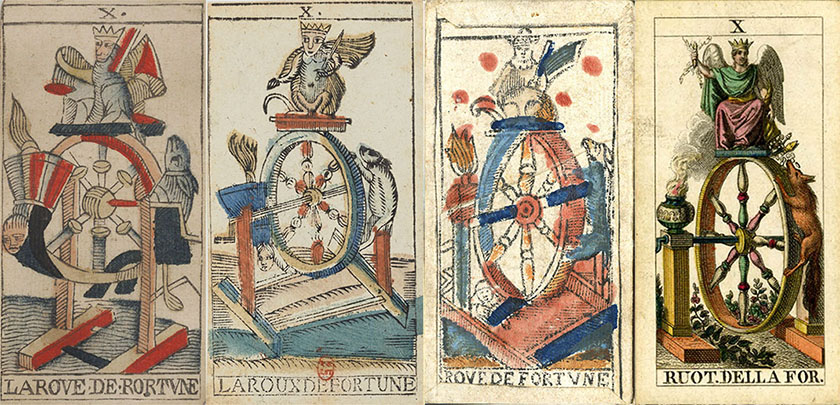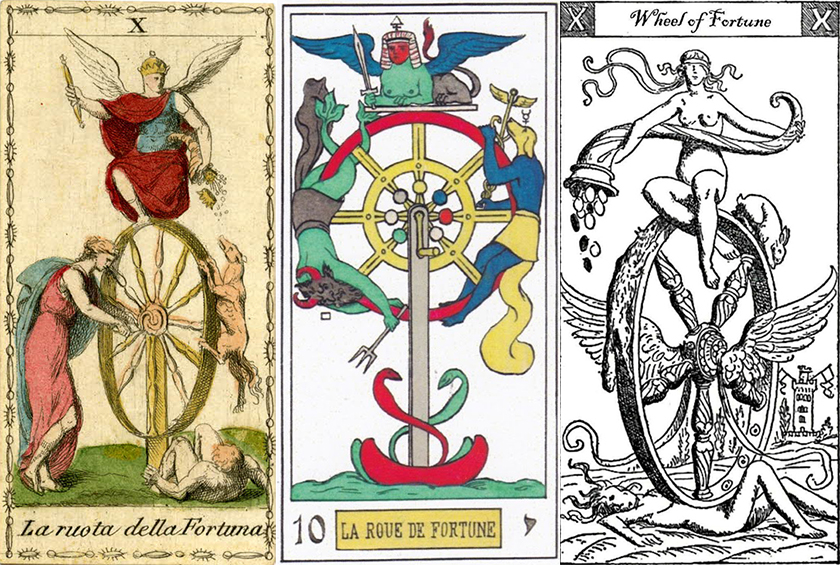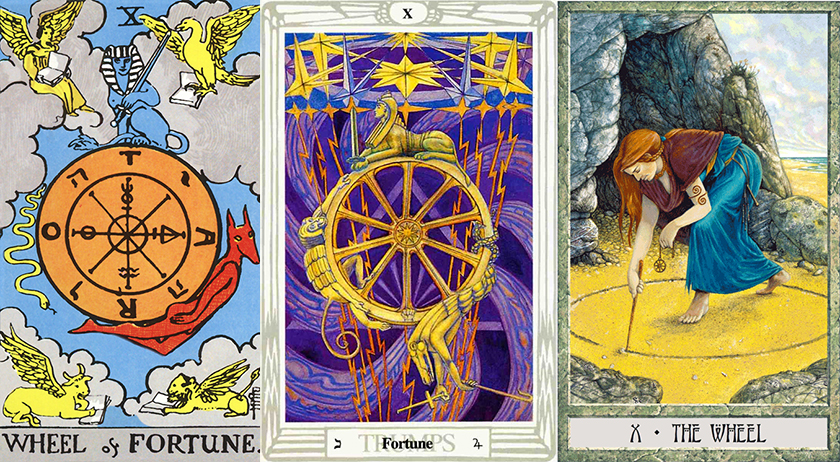THE TAROT WHEEL
LA ROTTA - THE WHEEL
The Wheel of Fortune was a very popular concept in the Middle Ages, for this reason we start this page with an image from a medieval Benedictine manuscript, the Carmina Burana. This manuscript dates to approximately 1200 and is conserved in the Bayerische Staatsbibliothek in München (Germany). In the front of the wheel we see Lady Fortune. She has turned her back to the wheel, so she is manipulating it blindly. We see a crowned person sitting on a trone at the top. He clearly is the ruling king and next to him is written "Regno" (I reign). But at any moment, when the wheel turns, he can be replaced. On the right side we see a person falling down and loosing his crown. He was the former king and next to him is written "regnavi" (I have reigned). On the left someone is going upwards, ready to replace the actual king. Next to him figures the inscription "regnabo" (I will reign). Finaly under the wheel a person laying down with the burden of the wheel upon him. He will never have the chance to rule and next to him is written "sum sine regno" (I'm without a Kingdom).
From the oldest handpainted Wheel of Fortune cards, only two cards survived, both of them created by Bonifacio Bembo for the milanese court, the first one commissionned by the duke Filippo Maria Visconti and the second one by his daughter Bianca Maria Visconti or her husband, the duke Francesco Sforza. :
The two cards are very similar. We remark that they are also almost the same with respect to the drawing in the Carmina Burana manuscript, even the same text (regno, regnavi, regnabo, sum sine regno) appears on the card at the right. The main differences are that Lady Fortune is blindfolded and that she has wings, indicating that she is not a real person, but that she is part of the population in Heaven. On both cards she is blindfolded and represented with her back to the wheel, she cannot see what she is doing, she is acting blindly. On the left side we see the Wheel of Fortune from the so called Brere Brambilla Visconti deck. The deck has been commissioned by the Duke Filippo Maria Visconti in the last years of his reign. Maybe the deck is unfinished, maybe the other trump cards burned with the Visconti castle in 1447. Only two Trump cards survived of this deck. The card at the right is from the Visconti Sforza deck, made in the early years of the reign of Duke Francesco Sforza. On both cards, the King on the top of the wheel and the ascending figure have donkey ears to indicate their stupidity to think that the power is reightfully theirs. The descending figure on the Visconti Sforza cards even gets a donkey tail. Except for the old man under the wheel, the figures on the wheel are depicted as children, emphasising the childishness of the struggle for power. Having the power is being at the right time at the right place, its all a question of luck and fate.
Let us now have a look at the oldest printed Wheel of Fortune cards, that have survived time on some rests and fragments of uncut sheets, to see how they present themselves.
From left to right we have the Wheel of Fortune cards as it appears on the Budapest sheets, the Rosenwald sheet, the Cary sheet and the sheet conserved in the Ecole des Beaux Arts in Paris. All sheets originate from Italy. The first three are dated around 1500, the last one dates probably a little bit later in the 16th Century. This last card is created in Bologna and is part of the oldest known (incomplete) Tarocchino deck. On the Wheel of Fortune from the Budapest sheets we see again the same inscriptions regne, regnavi, regnabo and sum sine regno. Lady Fortuna isn't present on any of the printed cards and some of the figures have been replaced by animals. Ignoring the details, the cards are using the same symbolism. It is clear that the oldest Tarot cards all use the same representation the Wheel of Fortune, so let us see how this symbol developped during the Centuries.
The concept of Lady Fortune as a goddess responsible for fortune, destiny and luck emerged for the first time during the Roman Civilisation. In the Greek civilisation there were many goddesses responsible for fortune, luck and destiny. There was the goddess Tyche who was the personification of chance and luck, Eutychia, the goddess of good fortune, Nemesis, the goddess who punished the people who had too much luck and the Moirea; Clotho, Lachesis and Atropos, the three goddesses of Fate. Although the Roman mythology also had three goddesses of destiny, the Percae, they were largely overshadowed in importance by Lady Fortuna who governed all the attributions of the different Greek gods cited above. The main attribute of Lady Fortune was the Cornucopia also called the Horn of plenty. Often she was veiled and blind and sometimes she was represented with a sphere that could roll in any direction, the precursor of the Wheel of Fortune.
The Wheel of Fortune as we know it today is attributed to the Roman philosopher Anicius Manlius Severinus Boëthius (better known as simply Boethius). A description of the Wheel of Fortune first appeared in his work called the Consolatio Philosophiae (the consolation of philosophy), a text he wrote in 524 in prison, when he was waiting for his execution. The text was very popular in the Middle Ages and copied many times. There are still some 400 Manuscripts of this text that survived time. So many depictions of the Wheels of Fortune exist, here below three random illustrations, such as they appeared in the Consolation of Philosophy. The three examples are from manuscripts created during the 15th Century, contemporary to the hand painted Trionfi cards.
We see that all these illustrations are based on exactly the same principles. The image of the Wheel of Fortune was very well accepted in the Middle Ages, and little variations exists. Except for the manuscripts, there are very few paintings known of the Wheel of Fortune. Surprisingly enough we find this Pagan symbol back in some Cathedrals. Here below three examples.
From left to right a mural painting of the 7th Century Cathedral of Rochester (England), a floor mosaic in the Cathedral (Duomo) of Siena originally created around 1372 (the actual mosaic replaced the original one and is made in 1864/1865 by Leopold Maccari) and a rose window of the Saint Vigilio Cathedral of Trento, a cathedral whose construction started in the 11th Century and achieved five centuries later. All representations respect the same pattern of the Wheel of Fortune with a king sitting on a throne on the top of the wheel, some people climbing up, others falling down and still others at the bottom, unable to improve their position on the Wheel.
Now we have seen that in the Middle Ages there was only one single representation of the Wheel of Fortune, let us have a look at the Tarot cards from the 17th Century and later.
The three first cards we show are all printed in Paris in the 17th Century. From left to right we have the anonymous Tarot de Paris, printed somewhere in the first half of the 18th Century. Next the Wheel of Fortune from the deck made by Jaques Vievil around 1650 and third the card from Jean Noblet, printed around 1657/1659. The Tarot of Paris gives a dynamic representation of the Wheel, where the figures are fighting for the place on top of the wheel. The Wheel cards of Vievil and Noblet are very similar, but the last one is mirrorred. The figure on the bottom of the wheel has disappeared. All three decks are conserved in the French National Library and all three illustrations are direct scans from the original cards. We remark how similar the three cards are, they use exactly the same colours. Also the pattern on the back of the cards is the same. I would not be surprised if all three decks have been printed on the same printing press.
Before returning to the Tarot de Marseille family of decks, let us first have a look at some Italian cards.
From left to right and from top to bottom we have the following decks: On the first line the Tarocco of Bologna, created by Francesco Berti, conserved in the Britisch Museum and dated to the second half of the 17th Century. Next an anonymous Tarocchino deck, conserved by the French National Library and dated to the first half of the 17th Century. Rightmost the Tarocchino deck created by Giuseppe Maria Mitelli around 1660/1668 for the wealthy Bentivoglio family. This particular deck is conserved in the French National Library. On the second line a Bolognese Minchiate deck, conserved in the British Museum and dated to the 18th Century. It is followed by a Fiorentine Minchiate deck, conserved in the British Museum and also dated to the 18th Century. The last deck is desiged in 1810 by Dellarocca and published by the Milanese card printing press Gumppenberg. This deck is also conserved in the British Museum.
The three cards on the top line are all from the 17th Century, so, except for the deck of Jean Noblet, older than any known Tarot de Marseille deck. Some scholars, like Stuart Kaplan, contest the dating of the Tarocchino deck in the middle, they judge this deck a century younger. However, this card is very similar (although mirrorred) to the card from the sheet conserved in the Ecole des Beaux Arts, dated to the 16th Century, so the dating of the French National Library to the early 17th Century might very well be correct. Note that the Tarocco di Bologna has French names, so it must have been inspired by a French deck. The cards of this deck are very similar the Tarot de Marseille decks. Even if there are no French decks surviving, it is extremely probable that many Tarot decks were published in France during the 17th Century, especially in and around the French town Lyon, the probable birthplace of the so called type I Tarot de Marseille decks.
Each of the representations of the wheel is typical for the specific style of cards it is representing. On the Tarocco di Bologna we see how the figure on the left is divided in two. We see only its head under the wheel, his tail (on the Tarot de Marseille decks this figure is an animal) became a flame. We will see this small head under the wheel on all later Tarocco di Bologna decks. On the Dellarocca deck the head disappeared, only the flame remained. On the Tarocchino deck the wheel is placed on the trunk of a tree. On the Mitelli deck all figures disappeared and a naked Lady Fortune is emptying a bag of money, very similar to the images of Lady Fortune with the horn of abundance. On the Minchate decks the wheel is floating in the air. On the Florentine Minchiate deck and on the Milanese Dellarocca deck we see how new printing techniques enable much more detailed illustrations on the cards.
Now let us go back to France and other neighbouring countries.
From left to right the 1713 type I Tarot de Marseille deck made by Jean Pierre Payen in Lyon, the 1784 Besançon type Tarot deck made by the Swiss cardmaker Bernard Schaer in Solothurn and a Belgium Tarot made by Jean Gisaine around 1760 in Bruxelles. The card of Jean Payen is similar to the card of Jean Noblet that we encountered earlier on this page. We also remark the resemblance between the Swiss Besançon style Tarot (that is from the same family as the type I Tarot of Marseille decks) and the Tarocco di Bologna with a mirrored base with respect to the Tarot de Marseille decks and very similar figures. The only difference between the Swiss Besançon card and the Tarocco di Bologna is that the figure on the left descending the wheel is not divided in two. The Belgium Tarot is completely mirrored with respect of the Tarot de Marseille. It is based on the Tarot of Vievil that we have seen above.
On the first glance it might not be seen but some of these cards illustrate very nicely how the image on a card could develop. Les us have a closer look at four of the cards above, the Tarot of Jean Payen, the Besançon Tarot, the Tarocco di Bologna and the Dellarocca deck to see an example of an image changing over time:
On the first card the descending figure is in the front. On the second card the base is mirrored and the figure moves to the background disappearing partially behind the axis of the wheel. On the third card the tail of the figure is transformed in a flame. From the figure remains only his hands and head below the wheel. On the last card finally the figure disappears completely and only the flame remains. Disturbing in this sequence is that the third card is probably the oldest. While the title of the Tarocco di Bologna cards is in French, this deck is most probably based on existing French decks, a hint that in France Tarot cards existed much earlier than the oldest surviving decks.
Later in time the Wheel of Fortune cards continue to illustrate a turning wheel. Sometimes the horn of plenty is added as a second symbol. Here below three cards from the 19th Century:
From left to right the early 19th Century Tarot of Lombardia, the Tarot of Oswald Wirth created in 1889 and the Vachetta Tarot dating from 1893. The Tarot of Oswald Wirth, that consisted only of the trump cards is the first in a long series of occult Tarot decks. We see the Egyptian symbology that was popular amongs the occult scene. Despite this, the Wheel of Fortune doesn't alter with respect to the Marseille Tarot. Both other cards also keep the medieval symbolism of the Wheel of Fortune, while adding the Horn of plenty.
Let us finish with some modern representations of the Wheel of Fortune card.
From left to right the RWS deck, the Wheel of Fortune from Aleister Crowley and the Druidcraft Tarot. The first two cards are from occult Tarot decks and we see the same Egyptian symbols as on the Tarot of Oswald Wirth. The third card is from a thematic Tarot deck. In all three decks the wheel stays the central element to symbolise luck, fate and chance.
From the images above it is clear that the main symbology of the Wheel of Fortune did not change. Fortune and destiny are beyond the control of human beings, we have to accept our fate. The concept of the wheel turning in a random direction, resulting one day in good luck but maybe the next date in misery, stayed the same since Boethius described it for the first time. The Wheel of Fortune in the Tarot is not necessarily a card announcing good luck, it rather is a card warning the reader to be carefull, good luck cannot be forced, it changes with the wind. And when the wind turns favorable in your direction, knows that one day your luck mightl fall down again.
